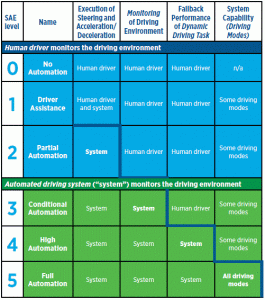To accept a fully automated vehicle we need to understand the levels of automation, but when we try to do that we realise that automated vehicles are already a reality and a proven technology. The level 1 of automation is already available in any new family car sold anywhere in the world. In this level we can find the commonly used Cruise Control (CC) that allows us to press a button and program the motor to maintain a certain speed, or go in an automatic way to a set speed value. More examples regarding this level are: Adaptive Cruise Control (ACC), the vehicle follows the front car and detect if it is accelerating or decelerating, or Park Assist (PA), where the steering is controlled by the automated system but the acceleration/deceleration is controlled by the human driver.
It is also a fact that advanced technology concerning the level 2 starts to be used in not only luxury cars. At this level we have the vehicles that are able to park without any human interaction, intelligent parking assist (IPA), and that with an automated system that controls acceleration/deceleration along with car´s movement in congestion areas, traffic jam assist feature (TJA)5. In sum, this level allows a human driver to get his hands off the wheel but still forces the driver to have his eyes on the road. See Tesla Autopilot4.
Level 3 will be the next level, with some technology already in an experimental phase, where the vehicle will perform in an autonomous way but with human supervision and interaction in specific occasions. These vehicles can carry out any decision like a human being would, but in some situations they will require intervention from the driver. Some companies are testing this technology as another stepping stone to reach the next level and this is the point where the interaction between human and machine starts to be discussed. Some accidents are caused by the fact that the human driver disrespected a specific rule, causing the accident, and maybe this will be the turning point of the whole discussion. Now is when we start questioning the actions of the machine, since it is not only assisting a human driver, but making decisions on its own.
At the same time that the technology evolves, so does the sociological discussion, and only this way we will achieve level 4 and 5, where no human interaction will be required. See Waymo2 and CityMobil23 (level 4). Until then, these first levels are real and understand them will allow us to reach to the next one. We hope this blog helps demystify the technology and contribute to the sociological discussion because this will happen, so as soon as we understand it, the better.

